Disclosure: Meeple Mountain received a free copy of this product in exchange for an honest, unbiased review. This review is not intended to be an endorsement.
Have you got your spears sharpened? Got some comfortable hides strapped to your feet? Ready to have your mind blown by this thing called “fire”?
Good! In that case, hello, and welcome to the Stone Age! It may come as a shock to you, but there’s a lot to see and do outside of these confines you’ve grown accustomed to. The world, as they say, is your oyster. Don’t worry. You’ll discover oysters eventually and that saying will make a whole lot more sense. For now, just sit back and enjoy the ride the walk.
In Fire & Stone, you will be working to spread your tribe’s influence across the surface of this new world. As you explore this vast world, you will be gathering food for your tribe, inventing new technologies to make your journey a little easier, and creating settlements along the way.
Fire & Stone features a little bit of point-to-point movement, some area control, and even a bit of tableau building. On a player’s turn, they will move one of their scouts around the board to either discover new tiles, forage for vegetables, hunt animals, or construct settlements—all in the quest for those all-important victory points. Once the eleventh Hut tile is discovered, the game will come to an end and the person with the most points wins.
Of course, this is a high-level overview of the game. If you just want to know what I think, feel free to skip ahead to the Thoughts section. Otherwise, read on and I’ll tell you how Fire & Stone is played.
Setup
This is how you set up a game of Fire & Stone:
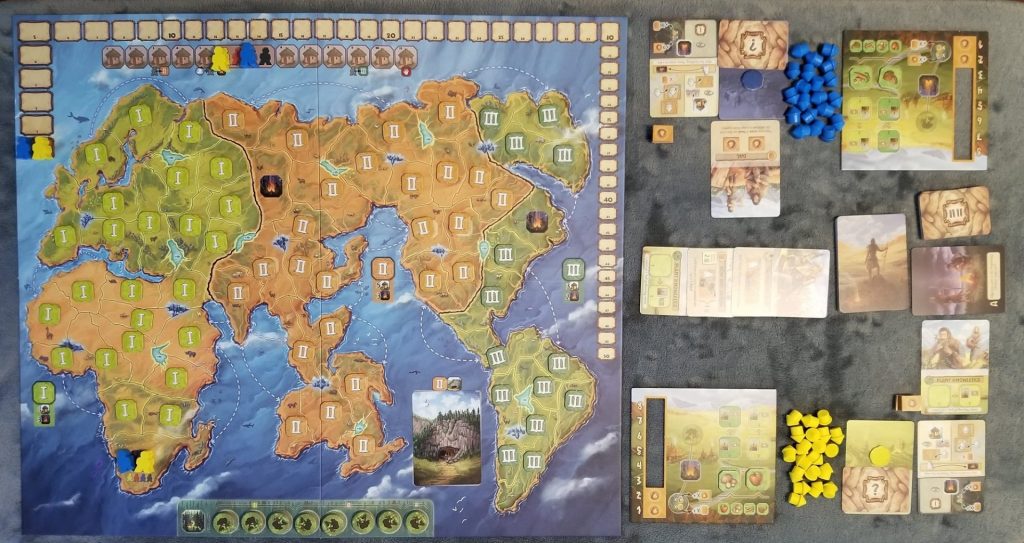
The game board is laid out between the players and each space on the board is covered with a face down Discovery tile. The I tiles belong in Region 1, II in Region 2, and III in Region 3. The deck of Cave cards is shuffled and one is selected at random and placed face down onto the cave space. The Animal tiles are shuffled and placed face down into even sized stacks on the spaces along the bottom of the board.
Each player begins the game with a Tribe mat, a Placement card, twenty Huts, a Marking Stone, two starter Gathering tiles, three Scout pawns, and a random starter Invention card (if playing with that variant). The other Invention cards are shuffled into a deck and placed close by. Three of these are drawn and placed in a row next to the deck. Each player places their Gathering tiles at the bottom of the two tracks on their Tribe mat. Their Marking Stone is placed onto the marked space on their Placement card. Each player receives a random Task card, looks at it, and places it face down onto the other marked space on their Placement card.
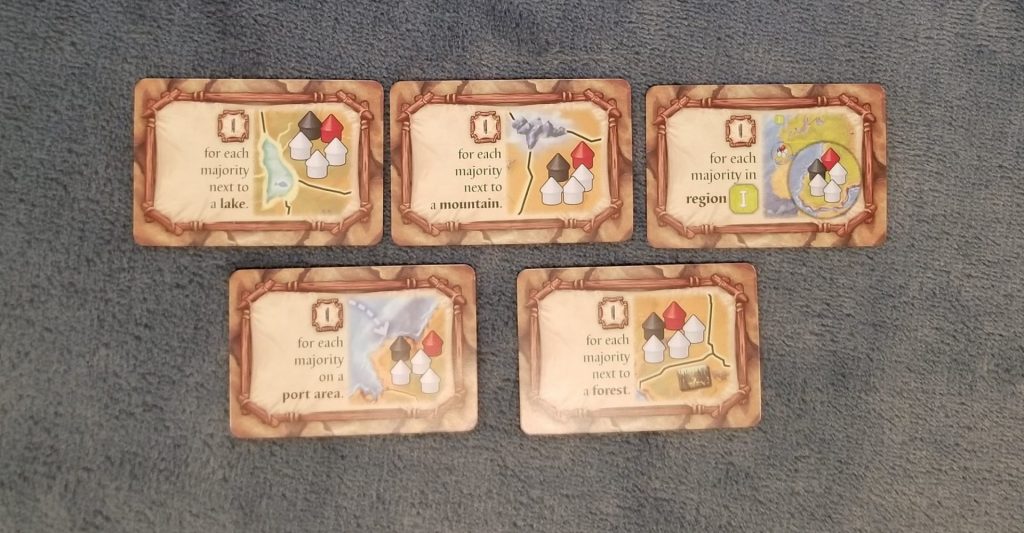
Lastly, players place one of their Scouts onto the Fire space in Region 1, another Scout onto the zero space of the score track, and the third onto the marked location in the middle of the Hut track at the top of the game board. The Food tokens and Bag tiles are kept in a general supply close by along with the “End Of Game” card. A starting player is chosen and you are ready to begin.
Exploring Your World
Each turn a player takes is divided into two main steps: movement, and taking an action. Of the two, movement is more easily explained. A player may move one of their Scouts up to two areas away from their starting position as long as they do not end their movement on the same area that they began. The player cannot move into Region 2 until that region has been unlocked (more on this later) and the same goes for Region 3. There is no limit to the total number of Scouts that can occupy the same area.
The second step, taking an action, is the real meat and potatoes of Fire & Stone. When a player’s Scout ends its movement in a location, they will first perform that location’s ‘discovery effect’ (if there is a face down tile on the location) followed by the location’s basic action (which is dictated by the face up tile at the location). The different types of tiles and their corresponding actions are:
FOREST: pick up a stack of Animal tiles for the current Region, look at them and select one to keep face down on your Tribe mat, and place the remaining tiles in a face down stack on top of the Forest tile in the Region space your Scout currently resides in. These Animal tiles are crucial as you’ll discover in the next two actions—Fire and Huts.
FIRE: for discovering the Fire tile, you move up one point on the victory point track. Then you may ‘cook’ any number of your face down Animal tiles as you like. These will always award some combination of Bag tiles (which increase your Food storage capacity) or Food tokens that are used in the next action. If arriving at a location containing an already discovered Fire tile, you may still cook your Animal tiles, but you don’t receive anything beyond whatever cooking those tiles rewards.

HUTS: for discovering a Hut tile, you may place one of the Huts from your supply onto the space for free and then move your Scout to a Fire token within the same Region. If arriving at a location where players have previously placed Huts, you can add one of your own Huts to the location by paying an amount of Food tokens to the supply equal to the number of Huts already there (including any of your own Huts that may have been placed previously). Huts gathered in a location this way are called a ‘settlement area’.
The Hut tile is removed from the location upon initial discovery and placed onto the Hut track. Certain breakpoints on that track will allow players to expand into different Regions as well as unlock a second Scout. This track also acts as a game timer. Once the track fills up, the end game is triggered.
GATHERING TILES: choose whether to leave the tile (and gain a single Food token for doing so) or add the tile to your Tribe mat. If you already have a Food tile of the same type stored on your Tribe mat, then the new tile is placed into the column above it which will cover up a Card space. This will allow you to take either an Invention card from the lineup or a Victory Point card which is placed on top of one of your already claimed Invention card’s text area rendering the card inoperable. Once a column gets filled up, it is emptied. If you do not have the Food tile type already, then it’s placed at the bottom of one of the columns (displacing any Food tile that might be stored there already).
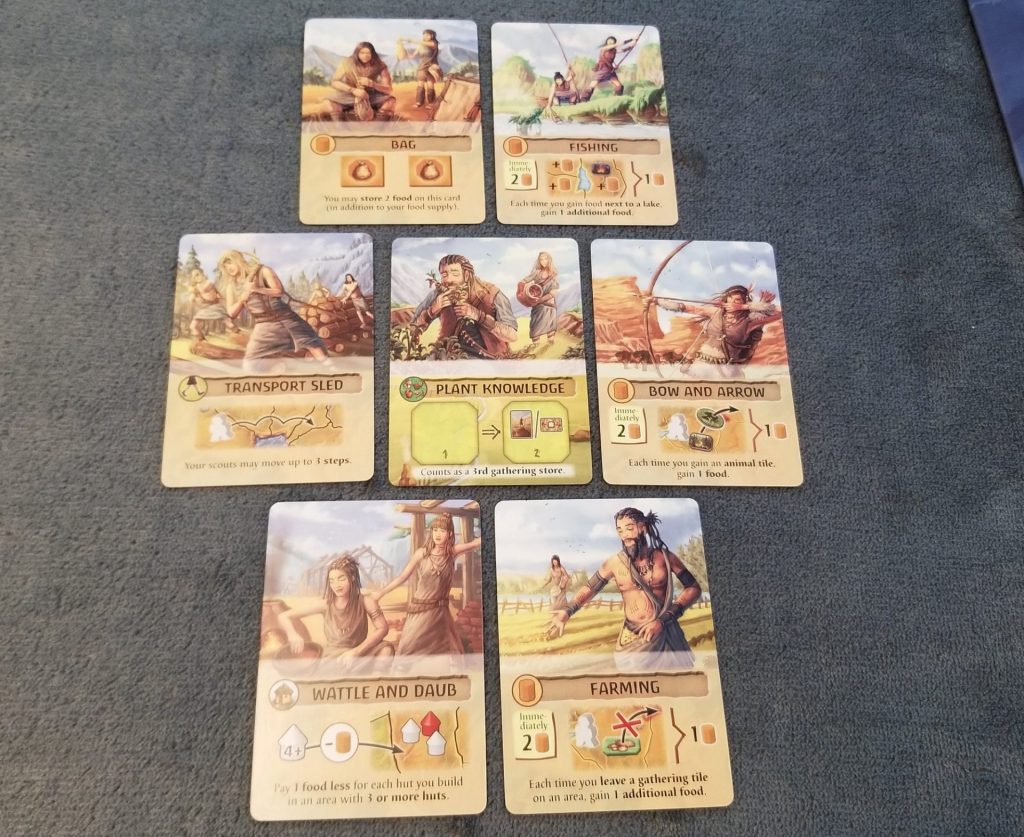
Invention cards are critical to doing well in Fire & Stone. Each Invention card provides some type of game-breaking ability such as allowing you to move along shipping routes, gaining extra Food for performing certain actions, or making it cheaper to place new Huts. A player may never have multiple copies of the same Invention card unless one of them is covered by a Victory point card.
SECRET STASH: these tiles provide you with whatever bonus is shown on the tile (some combination of Bag tiles and/or Food tokens) and then they are discarded.
CAVE: flip over the Cave card that was placed out during the setup. Each Cave card has a unique effect that remains in place for the remainder of the game. These provide a wide range of benefits from extra action spaces to one-shot victory point scoring opportunities.
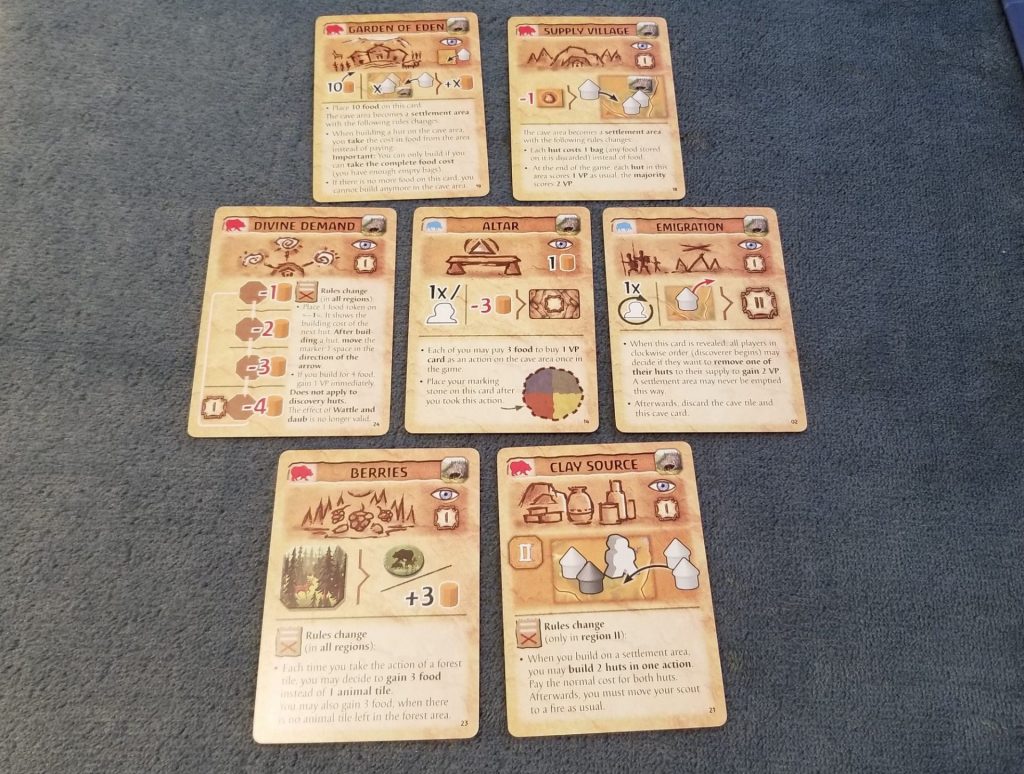
NO TILE: ending your Scout’s movement on a space containing no tiles will reward you with a single Food token.
End Game
The person that causes the eleventh Hut tile to be placed on the Hut track will trigger the end game. Once this Hut has been placed, that player will take the “End of Game” card into their possession and place it in front of them with the ‘A’ side face up. When it comes back around to them again, the card is flipped to its ‘B’ side and this signals the final round of the game. Once everyone has finished their final turns, the game comes to an end and players will tally their final scores.
Points come from a variety of places. In addition to any points they have earned over the course of the game, players will earn points from the following: points from Victory Point cards, one point per each of their Huts on the board, one point for each settlement area where their Huts make up the majority, and points scored from Task cards.
Thoughts
I have a thing for Carcassonne. To say that I love that game would be downplaying the way that I feel about it. It’s the game that really got me into this hobby. So, when Meeple Mountain was offered a review copy of Klaus-Jürgen Wrede’s newest game, I leapt at the opportunity. Outside of Carcassonne and its various spin-offs, I hadn’t had much experience with his other designs aside from playing games like The Downfall of Pompeii and Rapa Nui on Yucata. But I liked what I’d seen so far. Would Fire & Stone similarly impress? I ardently hoped that it would.
And now that I’ve had an opportunity to play it multiple times, I can render my verdict.
On the charge of being a merely ‘okay’ game: Fire & Stone, I pronounce you guilty.
I had high hopes that Fire & Stone would be something stellar. The game looks great laid out on the table. Hendrik Noak’s illustrations are perfect and the components are top notch. It’s the kind of production value I’ve come to expect from Pegasus Spiele. The rule book is a very well designed double-sided, multi-folded pamphlet. The verbiage is crystal clear with plenty of illustrative examples to guide you along the way. There’s even a handy Appendix included that goes into more detail about specific cards as well as answering some frequently asked questions. After reading through this material and getting the game set up, I was excited to dig in.
I like the way that each of the game’s various elements are so intertwined with the others. Aside from initially discovering Hut tiles, you can’t build Huts without Food. You can’t get Food without Fire and Animals. And more critically, you almost can’t accomplish anything at all without Inventions. Those are impossible to get without Discovery tiles. When this web of interconnectivity is set on top of a frame of randomness, however, problems arise. Much to my chagrin, this was an issue I discovered in my very first game and it left a terrible taste in my mouth.
To make a long story short, out of the twelve Hut tiles discovered over the course of that game, eight of them were discovered by me. And of the eight Fire tiles that existed in the game, six of them were discovered by me. Collectively, that was fourteen turns of the game where I wasn’t discovering Discovery tiles. Fourteen turns without any Forest tiles. Fourteen turns without adding any additional Invention cards to my tableau, much less Victory point cards. Meanwhile, my opponents were turning over Discovery tiles left and right and as things became progressively easier for them, my chances at competing in any meaningful way withered away. Even the prospect of scoring extra points from my Task card disappeared as Hut tile after Hut tile was frustratingly revealed next to some structure not called for by my Task.
I went from feeling elated to mildly annoyed to irritated to absolutely furious in the span of an hour. Needless to say, I wasn’t super excited about the prospect of having to play the game again. While the other players at the table generally agreed that they’d enjoyed the game, I couldn’t agree less. That first game of Fire & Stone left me feeling rageful.
Thus it was, with great trepidation, that I set out the game and played it for the second time several days later. The experience was like night and day. I don’t know if I just had exceedingly bad luck that first time or if I’d learned some valuable lessons that I subconsciously applied to that second play, but I played exceptionally well. In fact, I won. It wasn’t a blowout win either. The scores were close and nobody seemed to be struggling the way that I was in that first game. And that has been the experience ever since then. Every game has been close and everyone has generally agreed that they enjoyed the experience.
I guess my point is: buyer beware. Randomly placed tiles, randomly discovered tiles, randomly drawn cards: there’s a lot of randomness in Fire & Stone. And while that luck factor typically doesn’t affect the game in any meaningful way, it can. And when it does, it sucks. Especially if you’re on the receiving end of a bad run of it.
It is this aspect of the game that turns what could be an exceptional game into a merely ‘okay’ one. Fire & Stone’s not going to blow your socks off. But there is the potential for a fun time if given the chance.


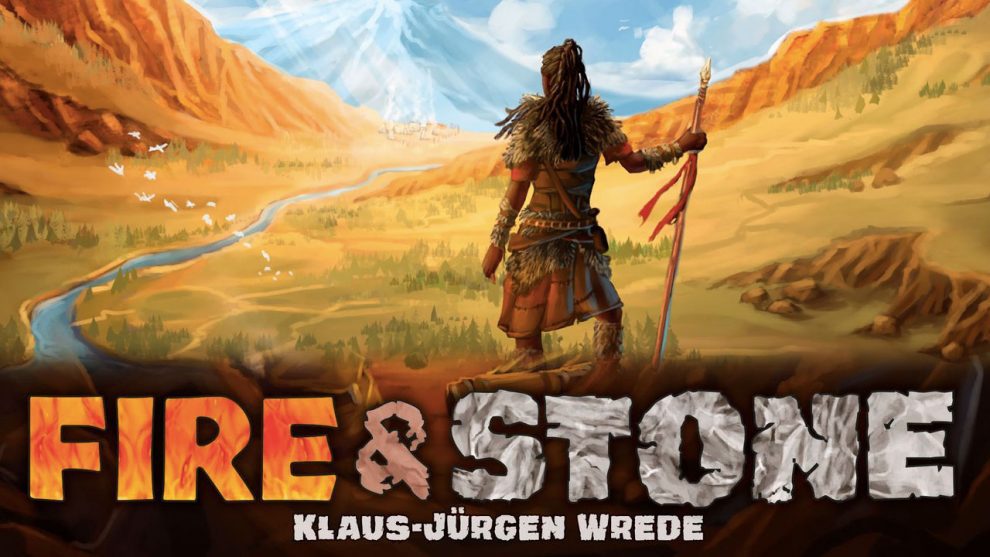









Add Comment